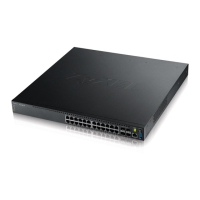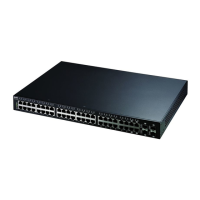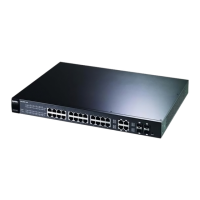Chapter 29 sFlow
GS3700/XGS3700 Series User’s Guide
314
The following table describes the labels in this screen.
29.2.1 sFlow Collector Configuration
Click the Collector link in the sFlow screen to display the screen as shown. You can configure up
to four sFlow collectors in this screen. You may want to configure more than one collector if the
traffic load to be monitored is more than one collector can manage.
Table 146 Advanced Application > sFlow
LABEL DESCRIPTION
Active Select this to enable the sFlow agent on the Switch.
Apply Click Apply to save your changes to the Switch’s run-time memory. The Switch loses these
changes if it is turned off or loses power, so use the Save link on the top navigation panel to
save your changes to the non-volatile memory when you are done configuring.
Cancel Click Cancel to begin configuring this screen afresh.
Slot (Stacking
mode)
This field appears only in stacking mode. Click the drop-down list to choose the slot number
of the Switch in a stack.
Port
(Standalone or
stacking mode)
This field displays the port number. In stacking mode, the first box field is the slot ID and
the second field is the port number.
* Use this row to make the setting the same for all ports. Use this row first and then make
adjustments on a port-by-port basis.
Note: Changes in this row are copied to all the ports as soon as you make them.
Active Select this to allow the Switch to monitor traffic on this port and generate and send sFlow
datagram to the specified collector.
Sample-rate Enter a number (N) from 256 to 65535. The Switch captures every one out of N packets for
this port and creates sFlow datagram.
poll-interval Specify a time interval (from 20 to 120 in seconds) the Switch waits before sending the
sFlow datagram and packet counters for this port to the collector.
Collector
Address
Enter the IP address of the sFlow collector.
Note: You must have the sFlow collector already configured in the sFlow > Collector screen.
The sFlow collector does not need to be in the same subnet as the Switch, but it must
be accessible from the Switch.
Note: Configure UDP port 6343 (the default) on a NAT router to allow port forwarding if the
collector is behind a NAT router. Configure a firewall rule for UDP port 6343 (the default)
to allow incoming traffic if the collector is behind a firewall.
Apply Click Apply to save your changes to the Switch’s run-time memory. The Switch loses these
changes if it is turned off or loses power, so use the Save link on the top navigation panel to
save your changes to the non-volatile memory when you are done configuring.
Cancel Click Cancel to begin configuring this screen afresh.

